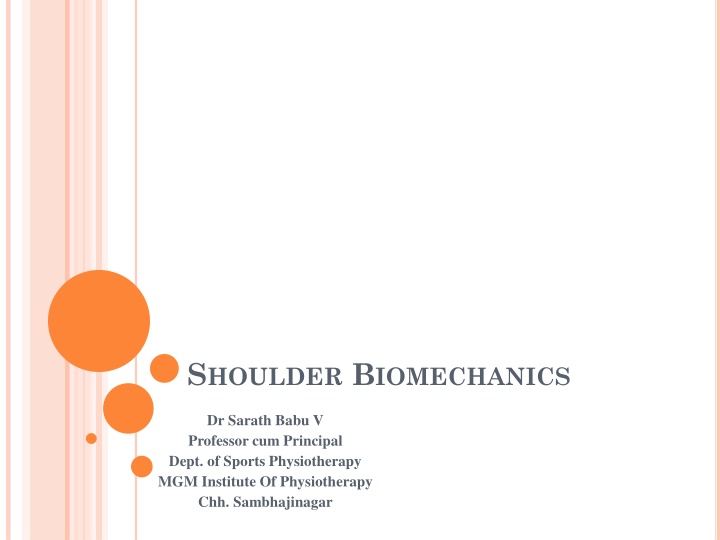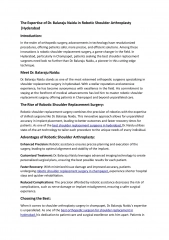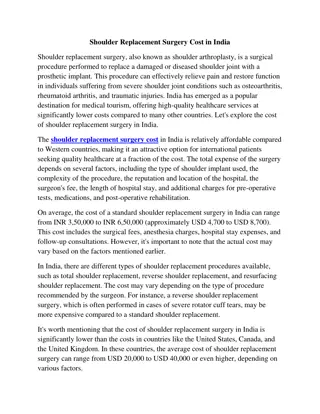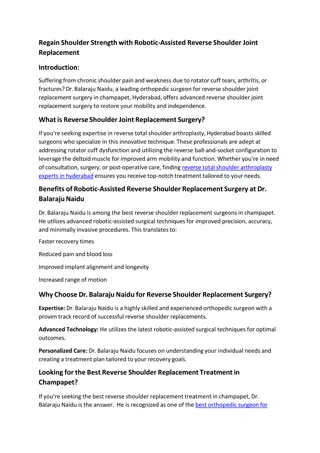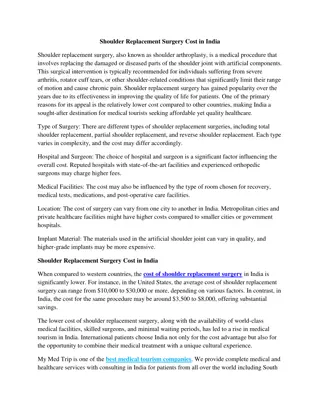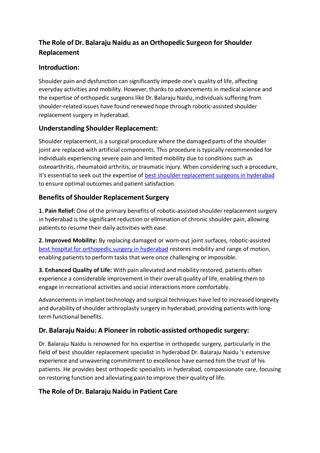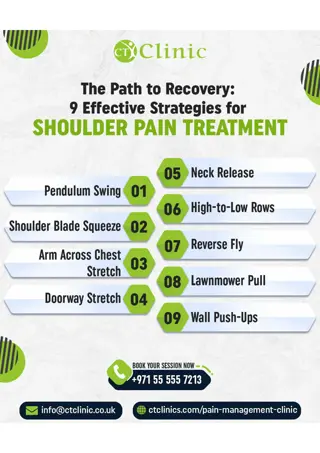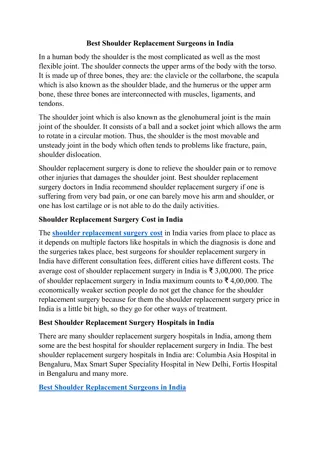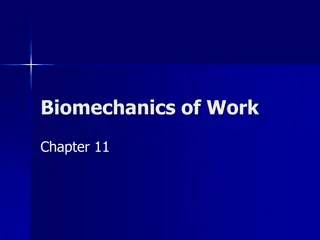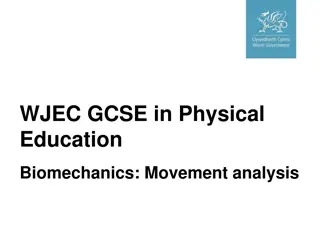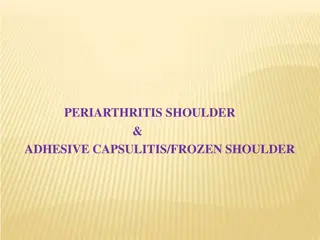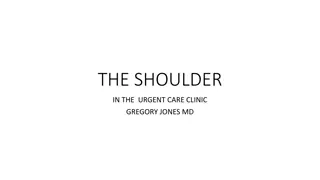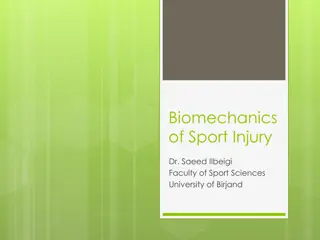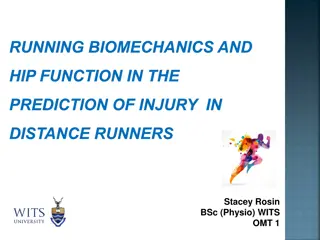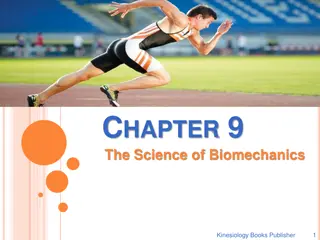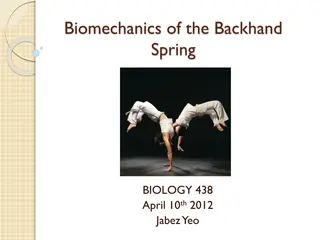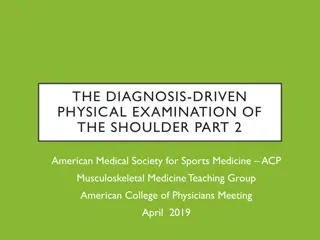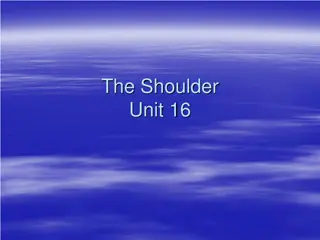SHOULDER BIOMECHANICS
The shoulder complex, consisting of the clavicle, scapula, and humerus, comprises three primary joints enabling a wide range of motion. Its articulations facilitate the elevation and positioning of the hand, with the glenohumeral joint providing exceptional mobility. The sternoclavicular joint connects the complex to the axial skeleton, while the scapulothoracic joint contributes to trunk motion, aiding in upper extremity elevation. Rotations at the sternoclavicular joint influence both clavicle and scapula movement, showcasing the interconnected nature of shoulder biomechanics.
Download Presentation

Please find below an Image/Link to download the presentation.
The content on the website is provided AS IS for your information and personal use only. It may not be sold, licensed, or shared on other websites without obtaining consent from the author.If you encounter any issues during the download, it is possible that the publisher has removed the file from their server.
You are allowed to download the files provided on this website for personal or commercial use, subject to the condition that they are used lawfully. All files are the property of their respective owners.
The content on the website is provided AS IS for your information and personal use only. It may not be sold, licensed, or shared on other websites without obtaining consent from the author.
E N D
Presentation Transcript
SHOULDER BIOMECHANICS Dr Sarath Babu V Professor cum Principal Dept. of Sports Physiotherapy MGM Institute Of Physiotherapy Chh. Sambhajinagar
The shoulder complex, composed of the clavicle, scapula, and humerus, is an intricately designed combination of three joints that links the upper extremity to the thorax. Shoulder complex acromioclavicular (AC) joint glenohumeral (GH) joint sternoclavicular (SC) joint scapulothoracic (ST) joint
The articular structures of the shoulder complex are designed primarily for mobility, allowing us to move and position the hand through a wide range of space. The glenohumeral (GH) joint, which links the humerus and scapula, has greater mobility than any other joint in the body.
They are connected to the axial skeleton by a single joint, the sternoclavicular (SC) joint. The articulation between the scapula and the thorax is often described as the scapulothoracic (ST) joint
The joints that compose the shoulder complex can, in combination with trunk motion, contribute as much as 180 of elevation to the upper extremity. Elevation of the upper extremity refers to the combination of scapular, clavicular, and humeral motion that occurs when the arm is raised either forward or to the side (including sagittal plane flexion, frontal plane abduction, and all the motions in between).
1. STERNOCLAVICULAR JOINT The sternoclavicular joint serves as the only structural attachment of the shoulder complex and upper extremity to the axial skeleton. The sternoclavicular joint is a plane synovial joint with three rotary and three translatory degrees of freedom. The joint has a synovial capsule, a joint disc, and three major ligaments.
Rotations at the sternoclavicular joint produce movement of both the clavicle and the scapula under conditions of normal function, because the scapula is linked with the lateral end of the clavicle at the acromioclavicular joint. Similarly, movement of the scapula often results in movement of the clavicle at the sternoclavicular joint.
ARTICULATING SURFACES Consists of 2 saddle shaped surfaces,one at the sternal end of the clavicle & one at the notch formed by the manubrium of the sternum & the first costal cartilage Articular connective tissue joint capsule Sternoclavicular Disc major ligaments
STERNOCLAVICULAR JOINT CAPSULE AND LIGAMENTS The sternoclavicular joint is surrounded by a fairly strong fibrous capsule but depends on three ligament complexes for the majority of its support: the anterior and posterior sternoclavicular ligaments, the bilaminar costoclavicular ligament, and the interclavicular ligament
STERNOCLAVICULAR DISC fibrocartilage disc, or meniscus, that increases congruence between the articulating surfaces.
During elevation and depression of the clavicle, the medial articular surface rolls and slides on the relatively stationary disc, with the upper attachment of the disc serving as a pivot point. During protraction and retraction of the clavicle, the sternoclavicular disc and medial articular surface roll and slide together on the manubrial facet, with the lower attachment of the disc serving as a pivot point.
provides stability by increasing joint congruence and by absorbing forces transmitted along the clavicle from its lateral end to the sternoclavicular joint.
Has 2 lamina-Anterior lamina & Posterior lamina Limits extremes of all clavicular motions except depression 3. Interclavicular ligament Spans over the jugular notch Checks excessive depression Protects the structures like Brachial plexus & subclavian artery.
STERNOCLAVICULAR JOINT LIGAMENTS : 1. Sternoclavicular ligament Anterior & posterior Check ant & post movement of head of clavicle 2. Costoclavicular ligament Strong ligament Extends from cartilage of first rib to costal tuberosity on inferior surface of clavicle
Kinematics/SC joint motion 1. Elevation depression It occurs around A-P axis Arthrokinematically, Elevation (0-45deg) upwards rolling & inferior slide of convex head of clavicle on concave manubrial facet of sternum Depression (0-15deg) inferior rolling & superior slide of clavicular head
Movement takes place bet medial end of Clavicle & articular disk So disk is a part of manubrium during this movt 2. Protraction Retraction It occurs around Vertical axis Range 0-15 deg each
Protraction anterior rolling & sliding of concave articular surface of clavicle on convex surface of manubrium Retraction same arthrokinematics in opposite direction Movment takes place bet articular disk & manubrium
Anterior Posterior rotation 3. Range 30-55 deg Occurs as a spin between saddle shaped surfaces of the clavicle & manubriocostal facet Posterior rotation from neutral
STERNOCLAVICULAR STRESS Degenerative change Dislocations of the sternoclavicular joint represent only 1% of joint dislocations in the body and only 3% of shoulder girdle dislocations.
ACROMIOCLAVICULAR JOINT The acromioclavicular joint attaches the scapula to the clavicle. It is generally described as a plane synovial joint with three rotational and three translational degrees of freedom. It has a joint capsule, two major ligaments, and a joint disc that may or may not be present.
The primary function of allow the scapula to rotate in three dimensions during arm movement so that upper extremity motion is increased, the glenoid is positioned beneath the humeral head, and the scapula remains congruent and stable on the thorax. The acromioclavicular joint also allows transmission of forces from the upper extremity to the clavicle.
ACROMIOCLAVICULAR ARTICULATING SURFACES The acromioclavicular joint consists of the articulation between the lateral end of the clavicle and a small facet on the acromion of the scapula
The articular facets are considered to be incongruent and vary in configuration. They may be flat, reciprocally concave-convex, or reversed (reciprocally convex-concave).
ACROMIOCLAVICULAR JOINT DISC The disc of the acromioclavicular joint may vary in size between individuals, within an individual as they age, and between shoulders of the same individual.
Acromioclavicular Capsule Superior acromioclavicular ligaments Inferior acromioclavicular ligaments Coracoclavicular ligaments
ACROMIOCLAVICULAR CAPSULEAND LIGAMENTS The capsule of the acromioclavicular joint is weak and cannot maintain integrity of the joint without the reinforcement of the superior and inferior acromioclavicular ligaments and the coracoclavicular ligaments
The acromioclavicular ligaments assist the capsule in apposing the articular surfaces while the superior acromioclavicular is the main ligament limiting movement caused by anterior forces applied to the distal clavicle. The fibers of the superior acromioclavicular ligament are reinforced by aponeurotic fibers of the trapezius and deltoid muscles, making the superior joint support stronger than the inferior.
The coracoclavicular ligament, although not belonging directly to the anatomic structure of the AC joint, firmly unites the clavicle and scapula and provides much of the joint s superior and inferior stability. This ligament is divided into a medial portion, the conoid ligament, and a lateral portion, the trapezoid ligament. The conoid ligament, medial and slightly posterior to the trapezoid, is more triangular and vertically oriented. The trapezoid ligament is quadrilateral in shape and is nearly horizontal in orientation.
The conoid portion of the coracoclavicular ligament provides the primary restraint to translatory motion caused by superior-directed forces applied to the distal clavicle The trapezoid portion of the coracoclavicular ligament provides more restraint than the conoid portion to translatory motion caused by posterior- directed forces applied to the distal Clavicle Both portions of the coracoclavicular ligament limit upwardrotation of the scapula at the acromioclavicular joint.
ACROMIOCLAVICULAR MOTIONS The primary rotary motions that take place at the AC joint are Internal/external rotation, Anterior/posterior tilting or tipping, Upward/downward rotation.
INTERNAL/EXTERNALROTATION Internal/External rotation of the scapula in relation to the clavicle occurs around an essentially vertical axis The orientation of the glenoid fossa is important for maintaining congruency with the humeral head; maximizing the function of glenohumeral muscles, capsule, and ligaments; maximizing the stability of the glenohumeral joint; and maximizing available motion of the arm. 30 for combined internal and external ROM
ANTERIOR/ POSTERIORTILTING Anterior/ Posterior tilting occurs around an oblique coronal axis(20 , although up to 40 or more may be possible in the full range from maximum flexion to extension.) Anterior tilting results in the acromion tilting forward and the inferior angle tilting backward . Posterior tilting rotates the acromion backward and the inferior angle forward.
Elevation of the scapula on the thorax, such as occurs with a shoulder shrug, can result in anterior tilting. During normal flexion or abduction of the arm, the scapula posteriorly tilts on the thorax as the scapula is upwardly rotating.
UPWARD/DOWNWARD ROTATION Upward/Downward rotation around an oblique A-P axis Upward rotation tilts the glenoid fossa upward , and downward rotation is the opposite motion. 30 of available passive ROM into upward/ downward rotation
ACROMIOCLAVICULAR STRESS trauma and degenerative changes. Trauma in contact sports or a fall on the shoulder with the arm adducted.
SCAPULOTHORACIC JOINT The scapulothoracic joint is formed by the articulation of the scapula with the thorax. It is not a true anatomic joint because it is not a union of bony segments by fibrous, cartilaginous, or synovial tissues.
Any movement of the scapula on the thorax must result in movement at the AC joint, the SC joint, or both. This makes the functional ST joint part of a true closed chain with the AC and SC joints and the thorax.
RESTING POSITIONOFTHE SCAPULA The scapula rests on the posterior thorax approximately 5 cm from the midline between the second through seventh ribs. The scapula is internally rotated 35 to 45 from the coronal plane, is tilted anteriorly approximately 10 to 15 from vertical, and is upwardly rotated 5 to 10 from vertical.
This magnitude of upward rotation has as its reference a longitudinal axis perpendicular to the axis running from the root of the scapular spine to the acromioclavicular joint. If the vertebral (medial) border of the scapula is used as the reference axis, the magnitude of upward rotation at rest is usually described as 2 to 3 from vertical. Although these normal values for the resting scapula are cited, substantial individual variability exists in scapular rest position, even among healthy subjects.
MOTIONSOFTHE SCAPULA The motions of the scapula from the resting position include three rotations that have already been described because they occur at the acromioclavicular joint. These are upward/downward rotation, internal/external rotation, and anterior/posterior tilting.
Of these three acromioclavicular joint rotations, only upward/downward rotation is easily observable at the scapula, and it is therefore considered for our purposes to be a primary scapular motion. Internal/external rotation and anterior/posterior tilting are normally difficult to observe and are therefore considered for our purposes to be secondary scapular motions.
The scapula presumably also has available the translatory motions of scapular elevation/ depression and protraction/retraction.
UPWARD/DOWNWARD ROTATION Upward rotation of the scapula on the thorax is the principal motion of the scapula observed during active elevation of the arm and plays a significant role in increasing the arm s range of elevation overhead. Approximately 50 to 60 of upward rotation of the scapula on the thorax is typically available.
Most often, scapular upward/downward rotation results from a combination of these sterno- clavicular and acromioclavicular motions. In describing upward and downward rotation of the scapula,use the inferior angle of the scapula as the referent,with upward and downward rotation described as movement of the inferior angle away from the vertebral column (upward rotation) or movement of the inferior angle toward the vertebral column (downward rotation).
Because the axes of the sternoclavicular and scapulothoracic joints are not parallel, the relationships between sternoclavicular and acromioclavicular joint motions and scapulothoracic motion are more challenging to visualize.
ELEVATION/DEPRESSION Scapular elevation and depression can be isolated (relatively speaking) by shrugging the shoulder up and depressing the shoulder downward. Elevation and depression of the scapula on the thorax are commonly described as translatory motions in which the scapula moves upward (cephalad) or downward (caudal) along the rib cage from its resting position.
Scapular elevation, however, occurs through elevation of the clavicle at the sternoclavicular joint and may include subtle adjustments in anterior/posterior tilting and internal/external rotation at the acromioclavicular joint in order to keep the scapula in contact with the thorax.
